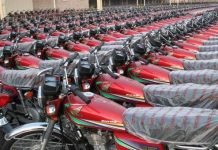The lopsided market structure of automobiles was discussed in this space a few months back in which we hypothesised that automobiles have essentially become an asset class preferred by investors as a proxy for an appreciating US$. In absence of any other asset classes which can closely track the appreciation of the US$, and preserve capital in real terms, investors have gravitated toward automobiles as a preferred asset class. Furthermore, in the absence of the ability to acquire US$ due to multiple restrictions on its acquisition, and a liquidity crisis, automobiles became an easy hedge to preserve the value of one’s investment in real terms.
Given the oligopolistic nature of the industry, and the absence of any imports (primarily due to excessive duties, and arbitrary bans due to a sovereign liquidity crisis), the bargaining power is skewed in favor of automobile manufacturers. Due to such a skew in bargaining power, automobile manufacturers have substantial pricing power which enables them to increase the prices of automobiles whenever there is any major depreciation of the PKR against major currencies. Any depreciation of PKR or increase in key input prices is immediately followed up by an increase in the price of automobiles. As prices are downward sticky, an appreciation of PKR or a reduction in input prices does not lead to a drop in prices mainly due to the ability of the manufacturers to exert pricing power and the absence of any competition through imported automobiles.
In effect, the nature of the industry has changed such that instead of manufacturing automobiles, it is also inadvertently creating an asset class that closely tracks any appreciation in foreign currency, better than any other asset classes available in the country. Due to such a market structure, there is never any shortage of orders for the industry, as it takes anywhere between six months to one year to get delivery of an automobile which is a generation or two behind the rest of the world. This is life under an oligopolistic market structure propped up by a protectionist regime.
Most buyers are looking to park idle capital, and sell off the automobile at a substantial premium at the time of delivery – this enables them to lock tax-free profits, often covering, and even overcompensating for any loss in value of the PKR. It is estimated that more than PKR 180 billion of customer advances have been deposited with various automobile manufacturers – such is the level of demand for automobiles. Considering the market structure, the demand looks inelastic, as the same is not being driven by consumer preferences for an automobile but to extract the financial benefit that exists through a hedging depreciation of the PKR. In such a scenario, it gets difficult, or simply unaffordable for consumers who actually want a car as a mode of transportation, rather than as a store of value, or as a hedge against a depreciating currency.
To reset the market structure, it is imperative that the financialisation of automobiles is discouraged. The same can be done through the imposition of capital gains taxes on sale of new automobiles. A consumer buying an automobile to use as a mode of transport will not be selling the same within a few weeks, meanwhile, an investor would be selling the same to lock profits from the same. Imposing a substantial capital gains tax (and obviously closing all loopholes to avoid the same) if a new car is sold within 12 months would disincentivise such activity, and hopefully redirect freed-up capital towards more productive avenues, while not creating a scenario that mimics inelastic demand in the short run. The higher the tax rate, the greater the disincentive, as that would essentially mean that the time value of money is negative. The capital gains tax can even be at an extreme of greater than 70%, to aggressively discourage a secondary market for new cars in the near term such that prices readjust. It is through the imposition of capital gains taxes in the secondary market that some order can be restored. It is essential to note here that this may not affect organic demand in the primary market, however, this would reduce any demand induced by the financialisation of automobiles.
A more traditional approach would be opening up automobile imports and reducing duties on the same, which would have a fairly instantaneous impact on local automobile prices. However, the same would lead to noise from the oligopoly, and would also use up precious foreign exchange reserves, which are in short supply in the near term.
The lopsided structure of the automobile market has been further skewed. Policy interventions are critical to reducing the oligopolistic nature of the market through greater competition. Similarly, disincentivising the allocation of capital which induces greater demand would also assist in balancing out the supply and demand of automobiles, rather than creating a fairly vertical demand curve in absence of any policy interventions.






















Welcome to Versatile Coupons, the final location for getting a versatile deal on your internet-based buys. Our central goal is to assist customers with enjoying you find the best arrangements and limits on the items you love. We comprehend that setting aside cash can be intense, particularly while shopping on the web. That is the reason we’ve made it our objective to present to you the best-in-class coupons and markdown codes from top retailers. Whether you’re looking for garments, gadgets, or home merchandise, we take care of you.